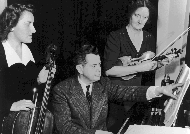PerformerSir Ernest MacMillan:
Maureen Nevins
|
 |
The Canadian Trio as they rehearse for a concert, ca. October 1941.
Photo by Ronny Jaques Studio, Toronto.
Download the above picture (134K)
. . . Canadians are still slow to recognize excellence in their young musicians until other countries put upon them the stamp of approval. However, we are gradually learning to trust our own judgment and to accord due recognition to a number of fine artists born in this country. 1
As previously mentioned, MacMillan was both an organist and a pianist. His 1904 performance at the "Festival of the Lilies" had astonished public and critics alike, and firmly established him as a prodigy.
During the months of April and May 1919, MacMillan undertook his first lecture-recital tour, visiting the western provinces. His organ recitals included comments on his experiences as a prisoner-of-war.
By then he was well-known in Toronto's music circles. His pre-war appearances at the organ were well-remembered and his recent triumphant return from Germany with his doctorate raised his profile among the public and his professional colleagues. Beginning in November 1919 through March of the following year, he presented a series of five organ recitals, part of an extensive program of concerts and lectures arranged by the Canadian Academy of Music.
In January 1920, shortly after his appointment as organist at Timothy Eaton Memorial Church, MacMillan began giving a brief recital following each of the Sunday evening services. Three months later, he gave the first recital independent from the services, a practice he continued regularly thereafter. Between 1923 and 1925, MacMillan annually presented a series of all-Bach recitals. These performances attracted members of the congregation, Toronto musicians and musical cognoscenti.
During the 1920s, he established his reputation, not only in Toronto but throughout Ontario and as far as Vancouver. In 1922, he was invited to play at the National Association of Organists' convention held in Chicago. As the first resident Canadian to receive this distinction, his performance drew rave reviews. However, in his memoirs, MacMillan comments on his rather poor performance and praises that of fellow Canadian Lynnwood Farnam, who held a leading church position in New York. Both were considered to be giants of organ playing on this continent. MacMillan was frequently invited to perform in the United States during the next two years. The U.S. press hailed him as "the Marcel Dupré of the North," and his reviews were always laudatory, here and elsewhere.
Although his most active period as a recital organist predated his appointment to the Toronto Symphony Orchestra, he continued to perform regularly throughout the 1930s and 1940s. Many of these performances were broadcast, including one series for the CBC in 1938 and another for the commercial Toronto station CKEY in 1945. MacMillan's most demanding appearance was perhaps at the 1935 annual Convention of the Royal College of Organists. Each year, immediately following the RCO examinations, an invited organist would perform all the obligatory test pieces which the candidates had been required to play. The audience included the cream of Britain's organ fraternity, the exam candidates and the general public. To be guest organist on these occasions was a great honour.
MacMillan's last public recitals took place in the early 1950s. According to his son Keith, it was at this time that MacMillan pondered his career as a recital organist. He felt it critical to decide either to devote more time to the instrument and resume a career on the organ, or to abandon it, in favour of the multitude of other responsibilities and duties to which he was committed. He chose the latter.
It was never MacMillan's intention to become a concert pianist although he enjoyed playing chamber music. The record of his participation as a pianist gives an indication of some 100 concerts and recitals between the 1920s and 1950s. He began performing with the Academy String Quartette in 1919 and by the early 1920s with the Toronto String Quartette and the distinguished Hart House String Quartet, founded by the Hon. Vincent Massey and his wife. One work which was regularly performed was César Franck's Quintet in F minor. On occasion he also performed with the Conservatory String Quartet, and once in Montreal with the McGill String Quartet in the early 1940s.
MacMillan frequently appeared as accompanist in recitals given by such noted singers as Emmy Heim, Lois Marshall, James Campbell McInnes and Ernesto Vinci. McInnes' work contributed greatly to the development of Toronto's musical life. His "Tuesday Nine O'Clocks" series of recitals were unusual programmes of little known vocal and chamber music. MacMillan met Emmy Heim in 1934 during her first visit to Canada. She sang for him and some friends and, as a result of the warm reception, made her Canadian debut that October with MacMillan as her accompanist. Apparently he became her favourite and their artistic relationship was unique. When he once appeared in recital with another prominent singer, she confronted him as having been "unfaithful."
In the early 1940s, MacMillan embarked on his most serious chamber music venture, in association with Kathleen Parlow and Zara Nelsova. The three formed the renowned Canadian Trio, under the management of the Oxford University Press. The group frequently performed in Toronto and elsewhere. MacMillan also teamed up with Parlow as the Canadian Duo. A number of their performances were broadcast by the CBC. On one occasion (November 1942), the Trio performed Beethoven's Triple Concerto in C major, op. 56, with the Toronto Symphony Orchestra at Massey Hall.
Notes
1. Ernest MacMillan, "Music Concert Performance," in Encyclopedia Canadiana (1958), Vol. 7, p. 225.
 [BACK]
[BACK]
 [FORWARD]
[FORWARD]